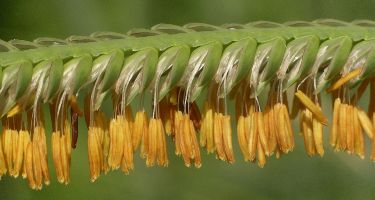 Eastern Gamagrass (Tripsacum dactyloides) male anthers | 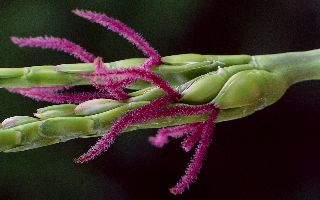 Eastern Gamagrass (Tripsacum dactyloides) female stigmas |
For those who think of grass as being nothing more than the green stuff that they mow in their yards in order to comply with neighborhood association regulations, it might come as a surprise that the plants actually bloom. All grasses, and there are over 200 species in our area of Texas, are flowering plants. However, as you may have guessed, the flowers are not big and showy. In fact, what some people mistake for grass flowers are not even grasses, namely the delightful little plants called Blue-eyed Grass (Sisyrinchium spp.) with their sky-blue blossoms. Although these look superficially like grass, they are actually in the Iris family! Many people have very colorful yards, with yellow Dandelions, purple Henbit, blue Speedwell, white Clover, and pink Evening Primrose. All of these flowers are borne by other plants living with the grasses.
Grasses are monocots, in the family Poaceae, and they are the third most diverse plant family, after orchids and composites (sunflowers, asters, etc.). While they do reproduce sexually by means of flowers, they don't have to generate structures that are attractive to bees and other insect pollinators. Instead, grass pollen is carried by the wind, which is why, along with many trees and some other plants such as Ragweed, they are responsible for the agony of allergy sufferers. In fact, the term "hay fever," which has come to be a generic term for all allergic reactions to wind-borne pollen, relates back to the grasses grown to produce hay for livestock.
Since grasses do not need to attract pollinators, their flowers are not endowed with attention-grabbing structures such as petals and sepals. Grass flowers are bare-bones sexual reproductive structures. The important parts of a grass flower include the pistil (stigmas that catch the pollen and the ovary that contains the egg) and the stamens (stalked anthers that produce the pollen). As is probably obvious, the pistil is the female part, in which the seed develops, and the stamens are the male. The seeds of grasses are contained in the fruit, or grain, which is what supplies much of our food (i.e. wheat, rice, corn).
Because flowers of grasses are so different from those of other plants, botanists have adopted special terms for the parts of each "blossom." The whole part of the grass plant that flowers is always at the end of a stem and is called the inflorescence. The typical lawn grass rarely manages to bloom because the flowers are cut off by the mower when they rise up above the plant, as they must do to catch the wind. Technical terms for the various parts and branches of the inflorescence are rachis, raceme, panicle, and spikelet. The actual flower is not even called that; instead it is a floret. The floret doesn't have petals, as mentioned earlier, but does have various modified leaves and other bits that protect the reproductively important parts and help distribute seeds. These little floret bits have labels such as glume, lemma, palea, and awn. I have never managed to get all these terms straight, so I don't use them. I just included them here for entertainment's sake.
Some grasses do not use flowers for all their reproductive needs. Many produce clones by sending out rhizomes (underground) or stolons (aboveground) which produce a new plant a short distance from the original. Thus a single plant can become a whole colony, but all the plants lack the genetic diversity which helps ensure the long-term survival that can only be accomplished through sexual reproduction.
 Eastern Gamagrass (Tripsacum dactyloides) male anthers |  Eastern Gamagrass (Tripsacum dactyloides) female stigmas |
While it is interesting to learn the nuts and bolts of plant anatomy, part of the reality of grass blooms is that they are simply lovely. There is a whole microcosm of tiny fragile shapes and delicate colors that appear for fleetingly short periods and often go unnoticed. Grasses do not bloom for long, but they do it each year. Some species have the male and female parts of their inflorescence develop at different times, which helps promote cross-pollination. The best and biggest example of this occurs on Eastern Gamagrass (Tripsacum dactyloides). The female stigmas range from white to purple and appear first, like fuzzy tentacles groping out of the tip of each seed. Shortly after they start to dry up, the male anthers, covered with golden pollen emerge a little farther up the stem. Although almost all grasses have male and female flowers on the same plant, one notable exception is Buffalograss (Buchloe dactyloides), which has separate male and female plants.
Here is an interesting characteristic about the common names of grasses that I didn't know until I started learning to identify the different kinds. It is standard practice to run the word "grass" right into the distinguishing name, without a space or even a hyphen. This results in some strange looking titles, such as Johnsongrass and Bermudagrass. Capitalization is not even necessary for correct usage.
The following photographs of various grass flowers illustrate the diversity and beauty of these minute botanical features. Most are common lawn grasses, sometimes desirable and sometimes considered to be weeds. No matter what our opinions of different species' worth, it cannot be denied that they are all little works of art.
 Barnyardgrass (Echinochloa crusgalli) | 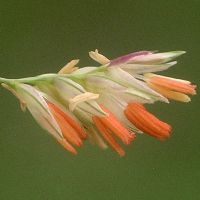 Buffalograss (Buchloe dactyloides) | 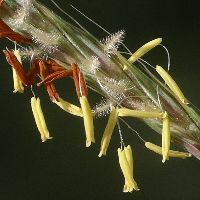 Big Bluestem (Andropogon gerardii) |
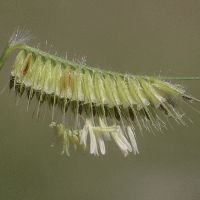 Hairy Grama (Bouteloua hirsuta) |  Hairyseed Paspalum (Paspalum pubiflorum) |  Johnsongrass (Sorghum halepense) |
 Bermudagrass (Cynodon dactylon) | 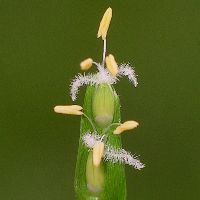 St. Augustinegrass (Stenotaphrum secundatum) |  Sideoats Grama (Bouteloua curtipendula) |